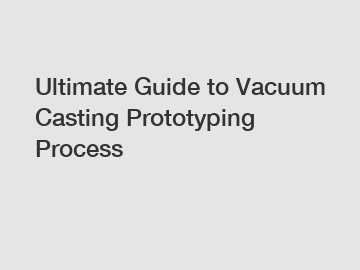Ultimate Guide to Vacuum Casting Prototyping Process
Sure! Here is a step-by-step guide to the vacuum casting prototyping process:
### Step 1: Create the master pattern.
Create a master pattern of the desired part using a 3D printing or CNC milling process. The master pattern should be made from a material that can withstand the vacuum casting process.

### Step 2: Create the mold.
Once the master pattern is ready, use it to create a silicone mold. The silicone mold will be used to create the final parts through the vacuum casting process.
### Step 3: Prepare the materials.
Prepare the casting materials, including the resin and any additives or colorants. Measure out the correct amounts of each material according to the manufacturer's instructions.
### Step 4: Mix the materials.
Mix the resin and any additives or colorants together in a mixing container. Make sure to mix the materials thoroughly to ensure a consistent end product.
### Step 5: Degassing.
Degassing is an important step in the vacuum casting process. Place the mixing container in a vacuum chamber and remove any trapped air bubbles from the resin mixture.
See also:Mastering CNC Milling for Intricate Components
Prototyping an Aluminum Extrusion
Subsurface Safety Valve
How can CNC machining benefit small runs?
How can rapid tooling benefit consumer products?
How to Save Money When Buying wholesale post tension wedges
4 Tips for Choosing an Extrusion Prototype Aluminum
### Step 6: Pour the resin into the mold.
Carefully pour the degassed resin into the silicone mold. Make sure to fill the mold completely to ensure a proper cast.
### Step 7: Place the mold in the vacuum chamber.
Place the mold in a vacuum chamber and remove any air bubbles from the resin. This will help ensure a smooth surface finish on the final part.
### Step 8: Cure the resin.
Allow the resin to cure according to the manufacturer's instructions. This may involve heating the mold to a specific temperature or allowing it to cure at room temperature for a certain amount of time.
### Step 9: Demold the part.
Once the resin has cured, carefully remove the part from the mold. You may need to use a release agent to help facilitate the demolding process.
### Step 10: Finish the part.
After demolding, trim any excess material from the part and sand or polish the surface to achieve the desired finish. Your vacuum casted part is now ready for use!
By following these steps, you can successfully create high-quality prototypes using the vacuum casting process.
Want more information on aluminum extrusion prototype design, aluminum extrusion prototype finishing, Low-Pressure Overmoulding VS Injection Mold Cost? Feel free to contact us.
See also:Unlocking the Answers: Key Questions to Ask When Ordering CNC Milling for Specialized Parts
Optimal Pressure for Torch Cutting: A Comprehensive Guide
Drilling granite
Key Questions to Ask When Ordering bend pipe fitting
Key Questions to Ask When Ordering Post-Tensioning Components
How Does Custom Metal Fabrication Services Work?
OT- Can I drill holes in marble as easy as granite




